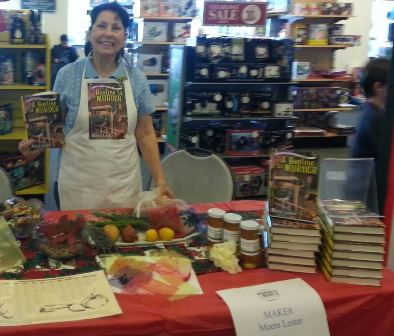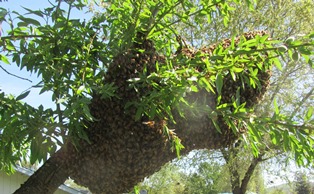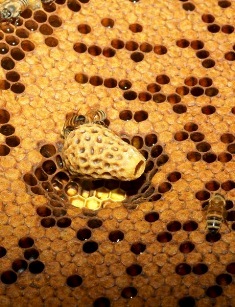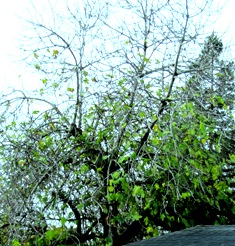Re-Cap of the Mini-Maker Faire at Barnes & Noble
My fingers still smell like French perfume lavender and rosemary from all the organza sachet bags I helped customers fill as a giveaway during the three day Mini-maker event this past weekend. Hosted by the Walnut Creek Barnes & Noble Bookstore, the event was a huge success for the store, the customers, and participating authors.

I wore an apron bearing the image of my book cover while I helped stuff bags with lavender and rosemary
All the signed copies of A BEELINE TO MURDER sold out and only a few unsigned copies are left. I gave away close to 100 organza bags and special embroidered bags I made for the event. Thank you citizens of the East Bay!
I met a lovely eleven-year-old boy who wrote novels. We exchanged email addresses and he’s already sent me his first two. I’ve promised to read and send him comments. All the while he was talking to me, I kept thinking “boy, did I get a late start writing.”
Another lovely customer bought the book for her mother back in North Carolina because winters on the other coast can be harsh, and a lover of mysteries can’t have too many on hand when the storms hit.
The mother of a Girl Scout invited me to do a presentation before their troop in early spring. I love the organization and will give it my best shot at the end of February or early March. It’ll be a chance to talk to the girls about writing books as a career, making things from nature, and having the courage to follow your heart (as I did when I established my farmette).
I enjoyed explaining to a darling Asian girl, while her parents looked on, the differences between wasps and honeybees. It was a great point of departure into a long conversation. We all became fast friends. She danced away holding her little bag of herbs beneath her nose.
In all, I had a great time. I think the store was pleased with all the “makers” who participated. And I’d do it again.
A BEELINE TO MURDER is available through your local Barnes & Noble stores as well as online at BarnesandNoble.com. Books make wonderful holiday gifts and foster the pleasure of reading.
Honeybees Have Distinct Personalities
I don’t wear perfume in the garden least the bees think I’m a flower and light on me. But if they do, I let them walk around and explore. I don’t swat at them. Why would I? Honeybees are generally among the most docile of all bees.
Honeybees also have different personality types, according to research published in 2012 in the magazine Science and based on a study by Gene Robinson, University of Illinois entomology professor and director of the Institute for Genomic Biology. See, http://news.illinois.edu/news/12/0308bees_GeneRobinson.html
Scavenging and reconnaissance work carries more risk and challenge, whether you are human or honeybee. An adventuresome personality is usually best suited for that kind of work. Robinson and his researchers observed that the honeybees that do the nest and food scouting express distinct patterns of gene activity in molecular pathways that have been associated with thrill-seeking.
Whereas the adventurous scouts choose the thrill of taking off, the more intrepid and timid bees tend to stick closer to home, doing the tasks of building the hive, cleaning it, caring for the babies, and making honey. Robinson’s research debunks the ages-old idea that the colony’s workers are interchangeable.
America’s first honeybees arrived in from Europe by ship to the American colonies in the 17th century. It took approximately 200 years for the honeybees to get to the West Coast from that early introduction. Some went feral. See, http://www.orsba.org/htdocs/download/Honey%20Bees%20Across%20America.html
The most aggressive honeybee personality is the Africanized bee (aka, killer bees). These bees attack (often in droves) if they perceive a threat to their nest or queen. See, http://www.independent.ie/world-news/americas/couple-attacked-by-swarm-of-30000-bees-who-kill-their-two-horses-29456104.html
The Africanized bees have spread from Brazil, where honeybees from Europe (highly valued for pollinating crops and producing honey) were interbred with bees from Africa. These bees were inadvertently released in the 1950’s in Brazil and began to migrate north. They are now in Texas, New Mexico, Nevada, Arizona, and California. See, http://bees.ucr.edu/ahb-facts.html
All this information about work and personality types as it relates to honeybees makes me wonder: If we humans suited our work to our personality types, would we work as contentedly as do the bees in the garden and those in the hive?
Winter, Time of Dormancy for Figs and Other Fruit Trees
Only four days remain until the official onset of winter. Drifting leaves from the Mission fig tree towering above my neighbor’s rooftop catches my attention. The fig’s thick trunk and spreading branches form a scaffold that sways against the western sky, pushed by a storm wind advancing from off the Pacific. It took most of autumn for the grand old fig to shed its canopy. Now most of its leaves lie on the ground like pieces of a discarded garment in Mother Nature’s closet.
Human hands, raccoon paws, and squirrel feet removed the tree’s fruit over the summer and fall. The fig remains picturesque with its lowest branches as thick as its trunk and with some trunks gnarled and covered with green moss.
The grand old fig stands stark and vulnerable, soon to rest in complete dormancy, in contrast to its unabashed fecundity during summer. The tree must await spring’s light and warmth to reawaken. For now, the fig’s heavy, gray bark finds resonance in weathered buildings, barns, and fences built more than a half century ago in this part of Contra Costa County.
During spring and summer, when its sap is rejuvenated and flowing with life-giving nutrients, the fig sprouts a lush canopy of bright green leaves. Later, it prolifically produces sweet fruit that grow as large as a man’s fist.
Mother Nature isn’t as precise as the dates on our calendars.Her seasons ease seamlessly from one into another. Colder and darker days of winter are yet to come. For many plants, the season of cold and storms is a time of rest; a dormant period from which they will emerge anew. The fig will again blossom, leaf-out, produce fruit in a new cycle. This is the promise of spring, the hope of gardeners. Until then, the tree has earned a much-needed rest.
 Facebook
Facebook Goodreads
Goodreads LinkedIn
LinkedIn Meera Lester
Meera Lester Twitter
Twitter








